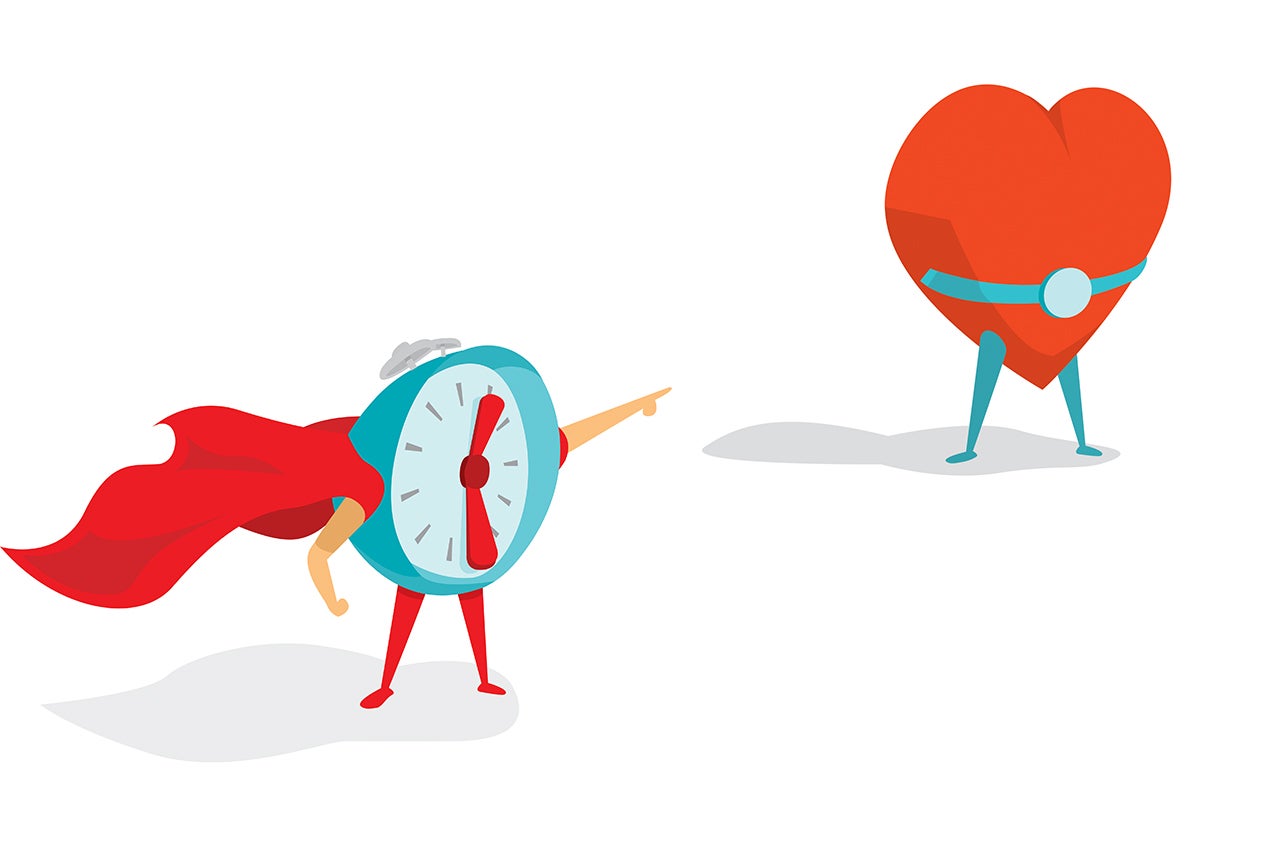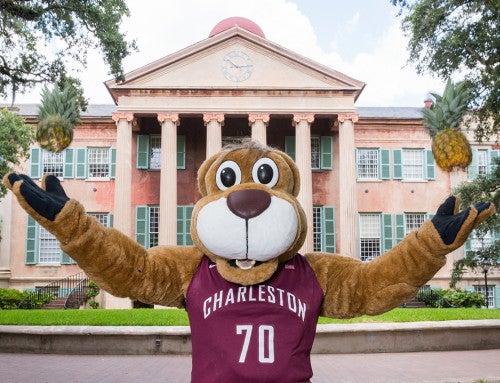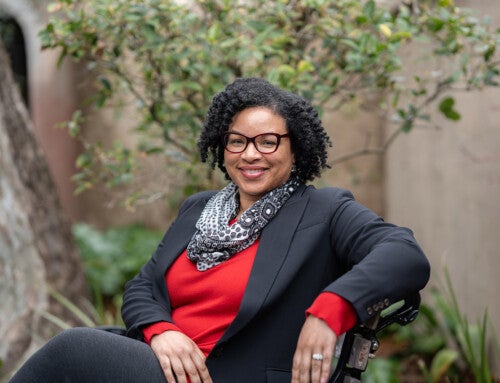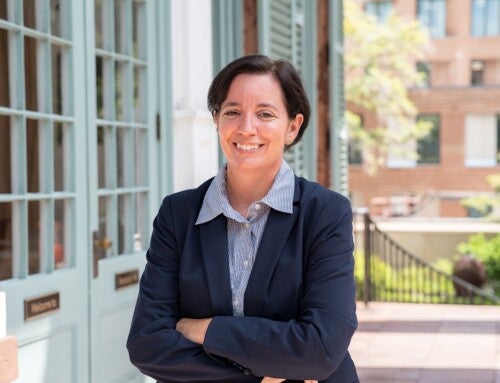No, you don’t have to be faster than a speeding bullet to be a hero – but, when it comes to sudden cardiac arrest, the faster you are, the better.
“Literally every second counts,” says Cpt. Tim Agee, CofC’s residence fire marshal, noting that, according to the American Red Cross, for every minute defibrillation is delayed, the chance of survival is reduced by about 10 percent. What’s more, National Safety Council statistics show that quick access to an automatic external defibrillator (AED) could increase the odds of survival from 5 to 40 percent.

The College has nearly 50 public-access AEDs like this one available across campus.
Fortunately, the College of Charleston has us covered: Through its AED Program established in 2009, Fire and EMS has steadily installed more and more public-access AEDs on campus, bringing the number to 46 and counting.
AEDs are portable computerized devices used to treat sudden cardiac arrest, a condition in which the heartbeat stops abruptly and unexpectedly. Using voice prompts, lights and text messages, AEDs walk users through every step of the way.
Of course, while these portable devices are designed to be used by the untrained bystander, we have to know where to find them in order to use them. According to an American Heart Association survey, only about half of all U.S. employees know where their workplace’s AED is located. Workers in schools and other education facilities were most likely to be able to find it, at 61 percent, but we can do better!
There’s no time to waste looking around – at least not if you want to save the day. The College has given us all what it takes to be heroes. The rest is up to us.
 Take the time now to locate the public-access AED closest to you:
Take the time now to locate the public-access AED closest to you:
- Addlestone Library, Security Desk
- Albert Simons Center for the Arts, First Floor Elevator
- Avery Research Center fir African American History and Culture, Lobby
- Beatty Center, First Floor Lobby Near Elevator
- BellSouth Building, First Floor Front Lobby
- Berry Hall, Entrance
- The Marion and Wayland H. Cato Jr. Center for the Arts, First Floor Near Elevator
- Craig Union, Admissions Lobby
- George Street Fitness Center, Entrance on Left
- Grice Marine Lab, Main Entrance
- Harbor Walk, East Building, Third Floor Lobby
- Harbor Walk, West Building, First Floor Lobby (Elevator)
- Jewish Studies Center, First Floor Beside Elevator
- Jewish Studies Center, Marty’s Place, Near Restrooms
- Mitchell Johnson Physical Education Center, Main Entrance
- Liberty Street Fresh Foods Company, Entrance
- Lightsey Center, First Floor Lobby Near Elevator
- Marty’s Place, Near Restrooms
- Maybank Hall, Cougar Mall Entrance
- Multicultural Center, Second Floor
- N.E. Miles Early Childhood Development Center (ECDC), Hallway
- North Campus, Lowcountry Graduate Center
- Patriots Point Athletics Complex, First Floor Hallway
- Patriots Point Athletics Complex, Tennis Facility, South Wall
- Patriots Point Marina, Stewart Walker Sailing Complex, Entrance
- Physical Plant Building, Calhoun Street Entrance
- Randolph Hall, Fountain Entrance, Near Elevator
- Rita Liddy Hollings Science Center, College Way Entrance
- Rita Liddy Hollings Science Center, First Floor, Near Restrooms
- Rita Liddy Hollings Science Center, Second Floor, Center Corridor
- Rita Liddy Hollings Science Center, Third Floor Center Corridor
- Robert Scott Small Building, Second Floor Lobby
- Rutledge Rivers Residence Hall, Lobby
- School of Sciences and Mathematics Building, First Floor
- School of Sciences and Mathematics Building, Second Floor
- School of Sciences and Mathematics Building, Third Floor
- Department of Sociology and Anthropology at 19 St. Philip Street
- Department of Sociology and Anthropology at 88 Wentworth Street
- College of Charleston Sottile Theatre, Lobby, Near Concessions
- Theodore S. Stern Student Center, Second Floor, Near Stairs
- College of Charleston Stono Preserve, Ponds Tract Field Station
- College of Charleston Stono Preserve, Tract Field Station
- TD Arena, First Floor, Practice Gym
- TD Arena, Concourse Level NE
- TD Arena, Concourse Level SW
- Thaddeus Street Jr. Education Center, Atrium Lobby
- Walker Sailing Complex, Entrance
- White Horse Stables, Stable Office
In addition, there are a number of AEDs on campus that are not publicly accessible. They are at the following locations:
- College of Charleston Fire 7 EMS Car 1701
- Department of Public Safety, Car 2
- Department of Public Safety, Car 3
- Fire and EMS Squad 1701
- Fire and EMS Squad 1711
- Fire and EMS Medic 1702
- Patriots Point Athletics Complex, Athletic Training Office
- School of Sciences and Mathematics Vans (4)
- Student Health Services
- TD Arena, Athletic Training Office
Familiarize yourself with this list, which is also available on the Fire and EMS website at https://fireandems.cofc.edu/aed/locations.php. To make sure you know how what to do once you locate the closest AED, visit firereandems.cofc.edu/aed/training.php for a video demonstrating how to use the College’s AEDs and for information on the AED training offered to the CofC community throughout the semester.
An AED is not a replacement for CPR. Perform CPR until an AED is ready to use, until signs of life are restored or until EMS or another trained responder has arrived to take over. It is important that you also call 911 in all emergency situations on campus, whether it’s to save a life, to stop a crime or to report a fire. For non-emergency matters on campus, call the Department of Public Safety at 843.953. 5609.
Remember, you don’t have to wear a cape or leap tall buildings in a single bound to be a hero. You just have to be prepared to act fast when it really counts. And when you do, everybody wins.
For more information about the College’s AED Program, including training and a full list and map of public-access AEDs on campus, visit fireandems.cofc.edu/aed/index.php.




